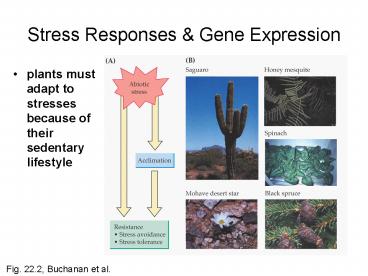Stress Responses - PowerPoint PPT Presentation
1 / 25
Title:
Stress Responses
Description:
Heat Stress (or Heat Shock) Response. Discovered in Drosophila, polytene chromosome puffing ... A sub-lethal heat shock allows organisms to survive a lethal treatment. ... – PowerPoint PPT presentation
Number of Views:317
Avg rating:3.0/5.0
Title: Stress Responses
1
Stress Responses Gene Expression
- plants must adapt to stresses because of their
sedentary lifestyle
Fig. 22.2, Buchanan et al.
2
Adaptation versus Acclimation
- Adaptation - evolutionary changes that enable an
organism to exploit a certain niche. These
include modification of existing genes, as well
as gain/loss of genes. - e.g., thermophilic enzymes in organisms that
tolerate high temperature - Acclimation inducible response(s) that allows
an organism to tolerate an unfavorable or lethal
(to some plants) change in the environment. - e.g., heat shock response
3
Types of Stress
- Abiotic
- 1. heat
- 2. cold
- 3. drought
- 4. salt
- 5. wind
- 6. oxidative
- 7. anaerobic
- 8. heavy metals
- 9. wounding
- 10. nutrient deprivation
- 11. excessive light
- Biotic
- 12. pathogens
- 13. herbivores
- Focus on heat, cold, anaerobiosis, oxidative,
and biotic stress
4
Plants respond to stresses as individual cells
and as whole organisms. Stress-induced signals
can be transmitted throughout plant, making other
parts more ready to withstand stress.
Fig. 22.3, Buchanan et al.
5
Heat Stress (or Heat Shock) Response
- Discovered in Drosophila, polytene chromosome
puffing - Specific response to temperatures 10-15oC above
normal growth temp. - Ubiquitous
- Conserved
- Rapid
- Transient
- Dramatic change in pattern of protein synthesis
6
Heat stress effects on protein synthesis in
soybean seedlings (J. Key).
7
Heat stress/shock protein synthesis in the
cyanobacterium Synechococcus.
8
Generalized order of events in heat shock response
- Initial events
- Inhibition of protein synthesis
- Inhibition of transcription RNA processing
- Induction of new hs (hsp) mRNAs
- Pre-existing cellular mRNAs still present but
not translated (initiation factor eIF4A B
deactivated)
9
Phase II events
- Partial restoration of protein synthesis, mainly
translation of hsp mRNAs - Accumulation of hsp (heat shock proteins)
- Gradual resumption of normal cellular protein
synthesis - Decline in hsp synthesis
10
Function Thermotolerance
- Enables organisms to survive high temp.
- Germinating seeds have naturally high
thermotolerance and have a lot of hsps - A sub-lethal heat shock allows organisms to
survive a lethal treatment. - Production of hsps correlates with acquired
thermotolerance. - Some mutants (yeast) and transgenic plants with
altered expression of certain hsps dont show
thermotolerance.
11
Thermotolerant growth of soybean seedlings
following HS.
28oC 40oC ? 45oC 45oC
Soybean seedlings.
Fig. 22.42, Buchanan et al.
12
(major) Heat Shock Proteins (hsp)
- 100, 90, 70, and 60 kDa
- Low molecular weight (LMW) hsp 27, 20-22,
15-18 kDa - all induced within 30 min.
- more LMW hsp in plants
- 2-Dimensional gel electrophoresis and molecular
cloning indicates most hsps are families of
related proteins, particularly hsp70 and the LMW
hsps
13
HSP functions
- 1 LMW hsp is ubiquitin, which tags proteins to
be degraded by the proteasome - Chloroplast translation elongation factor eF-Tu
(nuclear-encoded) (also has chaperone act.) - hsp90, hsp70, and hsp60 involved in protein
folding "molecular chaperones" - hsp100 promotes translation of hsp and other
mRNAs (Ferredoxin), via a CAP- independent
mechanism (can be knocked out, plants grow but
have reduced thermotolerance)
14
HSP70, a chaperonin
- Essential gene
- Homologues found in cytoplasm, ER lumen,
mitochondria, and chloroplasts - Function in protein targeting and assembly in
normal (non-stressed) cells, hydrolyze ATP - Constitutive heat-induced (cytoplasmic) forms
- the heat-induced form first appears in the
nucleolus, then goes to cytoplasm (may protect
pre-ribosomes from heat stress?) - Also, some hsp70s are light-induced chloroplast
hsp70 helps protect PSII from light/heat damage
in Chlamy.
15
Chaperones bind short hydrophobic and/or
positively charged stretches of amino acids.
16
HSP60 (cpn60)
- First one termed "molecular chaperone.
- Discovered as the RuBPCase LS binding protein
that participates in assembly. - In eucaryotes, only in mitochondria and plastids.
- Similar to E. coli GroEL gene.
- Exists as abundant 720-kD complex with two
subunits of 61 and 60 kDa (ATPase). - Associates with cpn10 (GroES homologue).
- Facilitates folding/assembly of other proteins.
17
Movies! http//people.cryst.bbk.ac.uk/ubcg16z/c
haperone.html
18
LMW HSPs
- highly heat-induced
- 4 nuclear gene families
- Class I cytoplasmic
- Class II cytoplasmic
- Chloroplast localized
- Endomembrane localized (ER)
- found in organelles only in plants
- function mostly unknown (some are also appear to
be chaperones) - aggregate in vivo into "heat shock granules
- Maybe processing denatured proteins
19
HSP regulation
- most work on LMW hsp in plants
- induction is mainly transcriptional but also
translational control (hsp mRNAs preferentially
translated) - genes induced coordinately, but not equally in
all tissues - light can also induce some LMW hsps and hsp70
20
Soybean Hsp mRNAs that are strongly induced.
Temp. oC
21
Cis-acting transcriptional regulatory elements
- HSE (heat shock elements) in the 5' regions
- 10-15 bp (contain partial palindromes)
- multiple copies required
- also found in other HS genes (e.g., hsp 70)
- similar to HSEs in animals
22
HSEs in plants and animals.
23
Heat-shock transcription factor (HSF)
- Studied mostly in animals and yeast, but also
plants. - Binds to HSEs.
- Contains leucine zipper motifs.
- Binds DNA as a trimer
- Activity is induced by heat, and
phosphorylation. - Activity repressed by HSP70.
24
Tomato HSFA2 has NLS and NES - Cytoplasmicnucleus
distribution part of control
Fig. 22.43, Buchanan et al.
25
Fig. 22.44, Buchanan et al.































